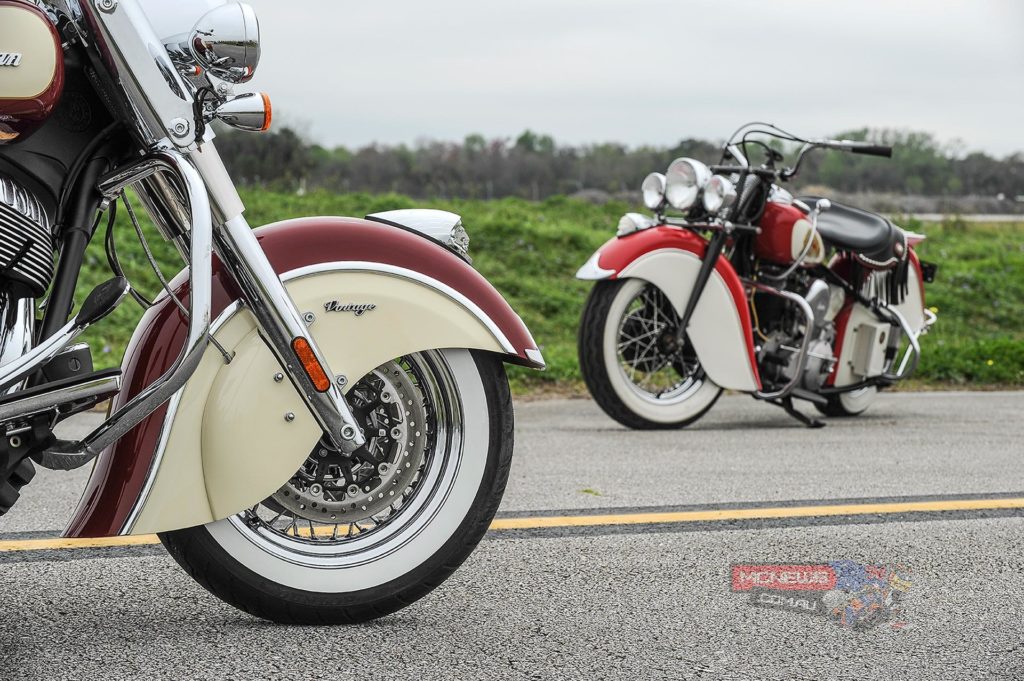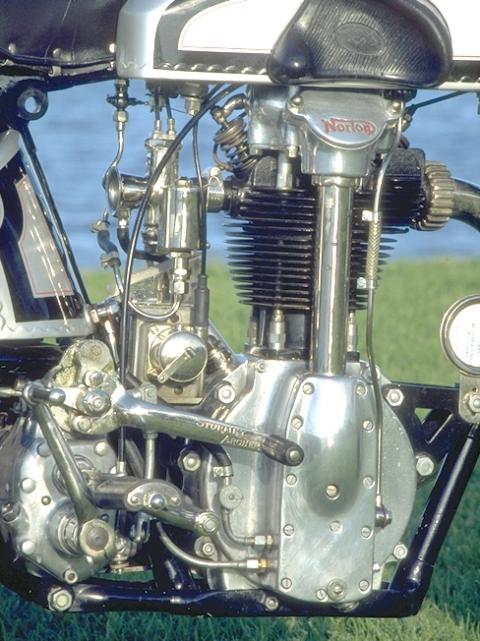Tradition and heritage in motorcycle history | With Phil Hall

Suzuki recently announced a 2015 version of the GSX-R that had a “heritage” colour scheme. Trouble was, the colours involved were mostly red. It seemed a little odd to me, since Suzuki’s corporate racing colour has always been blue, where the “heritage” bit came in and, at the same time, it prompted me to examine how the word and the word “tradition” are being somewhat misused in similar areas of motorcycling.
The 1970’s saw the effective end of the British motorcycle industry. A country that had, for many years, produced a bewildering array of brands, models and motorcycle types, surrendered its position as the world #1 to Japan and the great British brands disappeared, almost without a trace.
It is not the intention of this article to examine in detail the multitude of reasons for the demise of the British motorcycle industry, but I do want to touch on a few aspects that were contributory factors. Some of the reasons were economic. Union militancy and power meant that construction costs rose dramatically while production quality dropped accordingly. The great British brands were mired in the 1930’s way of doing things and were reluctant/unwilling to change in order to be able to compete with the flow of cheaper, better quality, Japanese machines. A slow parallel twin just didn’t cut it when you could have a 4 cylinder bike with a disk brake on the front and reliable electrics for a cheaper price.
There were design issues also that struck at the very core of why the British manufacturers couldn’t compete. British bikes, known for their propensity to leak oil, did so for two main reasons. Firstly, most designs featured a vertically-split crankcase. Consequently, the oil in the sump had a much easier time escaping than from the sump of most Japanese bikes whose crankcases were split horizontally. And secondly, by the time the 70’s rolled around, engine castings and casings were still being produced on antiquated machinery from pre-WWII and the machines themselves were worn out. If there are huge tolerances in the machines that are being used to machine the crankcases, those tolerances are going to inevitably be transferred to the casing that the machines make.
So most British bikes leaked from the moment they left the factory and no amount of gaskets and sealants were going to prevent that because the facings where the casings met were not exact.
British electrics were also suspect. It is not without reason that most owners of British cars and bikes know the joke that Joseph Lucas was the Prince of Darkness. One road test in the 70’s remarked that the headlamp on a British bike was so weak that it repelled moths.
And the condition of British roads didn’t help either. In poor condition for decades afterwards due to the depredations of war, slathered in salt to melt the inevitable winter ice and subject to awful rain and sleet for a large portion of the year, they pounded and rusted the bikes to bits, making them old well before their time.
In fact, it is probably fair to say that the British motorcycle industry survived for much longer than it had a right to do so given the combination of adverse circumstances that befell it in the 60’s and 70’s.
In racing it wasn’t any better. Long the staple of the privateer, the Manx Norton survived the early onslaught of the Italian multis only to be dealt the hammer blow of the Japanese versions of the same thing that were even faster, produced in higher volumes and they soon relegated the Manx to a mere sideshow.
So the British motorcycle industry finished, not with a bang, to quote the poet, but with a whimper. The age of the UJM was ushered in and the antiquated British bikes ended up in scrap yards or museums.
But there were some who were not prepared to let it die. Several attempts were made to keep Triumph going, including the Meriden Co-Operative but it folded in the end as well.
The Norton name was sold to an American millionaire who produced an increased capacity Commando into the 80’s before finding that owning a motorcycle name and actually doing something profitable with it, were two entirely different things.
And so passed Triumph, Norton, Ariel, BSA, Matchless and a host of other revered names. The carnage was most notable in Britain but it had echoes elsewhere as well. The USA had once been a powerhouse of motorcycle production too, but, by the mid-70’s even the greatest American company, Harley Davidson, was sold to an Italian firm for a ridiculously small amount and, for some time, they produced small two-stroke trail bikes, Aermacchis in their souls, but Harley Davidson on the tank. The great Italian rider, Walter Villa, won four World Championships on 250 and 350cc Harleys (there’s a trivia question for the next night at the pub)
Motorcyclists who have grown up in the era since the 70’s may not even know some of these names so completely did they disappear. But nostalgia isn’t just a thing of the past and there were enough people who longed for a revival of the British industry to try and do something about it. Several attempts were made to revive the Triumph name, but all failed in the face of unspeakable costs that had not been factored in before the dive was taken.
Till finally we arrive at the latest attempt, funded by a man with incredibly deep pockets and a burning passion to revive the name. I don’t know how many people had owned it in the intervening years but it ended up in John Bloor’s top drawer. Bloor understood two things. Firstly, that, if you want to mass produce and build a bike that would sell, you had to build a bike that fitted the current market. Yes, there are still those who hanker for a simple parallel twin, but that’s not where your profitability is going to lie. Bloor catered for that niche by producing the Thunderbird, and very successful it has been too. But he also produced a series of British Japanese bikes. Different enough to set them apart a little, but essentially built on the same template. While not built and sold in the numbers managed by the competition, modern Triumphs are doing quite well, thank you very much.
In similar fashion, there have been many attempts to revive the other famous British name, Norton. And today we have a small company bearing the name producing what are essentially 21st century versions of the Commando and its ilk. Still vertical twin and still with a similar look and feel but with oil-tight engines, reliable electrics and modern running gear. A much smaller company, Norton is struggling, with anecdotal evidence suggesting some less-than-savoury business practices and a lot of broken promises. However, it is still there and a local company has taken on the rights to distribute the brand here in Australia. They will sell in far smaller quantity than their British competition, being priced absurdly higher than what they should be, even for a “boutique” brand.
The car manufacturer, Ariel, who produce the bonkers range of Atom vehicles, has recently announced that they have purchased the long-dead name of the motorcycle company and are planning on producing two motorcycles, both at the “crazy” end of the spectrum and both selling for what are predicted to be absurd prices.
On the other side of the pond, the on-going saga of the Indian name should be the subject of a book, if it hasn’t already been. I have no idea how many individuals and companies have owned the name over the years and the number of failed attempts to relaunch the brand has been high. But now that ownership of the name seems to have been settled we are seeing “new” Indians on the showroom floor. Based on the tried and true V-Twin formula, Indian is seeking to be the “other” motorcycle manufacturer after H-D. Another “boutique” brand, the market into which they are seeking to sell is far more tolerant of high prices being paid for exclusivity, and they seem to be managing OK at the moment, launching a brand new model over the weekend at the annual Sturgis motorcycle festival.
However, I must close with a warning, or perhaps a caution. Not one of these bikes has any historical connection with the brands they bear on their tanks. Owners of modern Triumphs can bang on about the Triumph “tradition” all they like but their bikes are simply not part of it. The great brands died and we mourn their passing. A modern Indian, Norton or Triumph has NO lineage stretching back to the bikes that bore the name back then. Even if they are built in the SPIRIT of those bikes, the lineage stopped when the factories closed. The present owners of the names own the name, that’s it. They didn’t purchase the heritage or the continuity from the original manufacturers. And, as I have mentioned, that name, no matter how hallowed we may regard it to be, has passed through many hands since back in the day and it was often sullied in the process by the questionable ethics of the people who owned it.
So, let’s enjoy and admire the varying interpretations of bikes produced by companies who have seen it as their duty to keep the great names alive. Let’s be grateful that modern companies produce good bikes, great bikes, with names that resonate of another wonderful era. But let’s not fall into the trap of believing that these bikes continue the “heritage” or “tradition” of the great names emblazoned on their tanks, because, sadly, they just don’t.
























